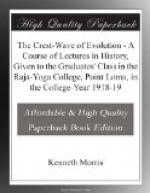There is a tendency with us to derive all things Indian from Greek sources. Some Greek writer says the Indians were familiar with Homer; whereupon we take up the cry,—The Ramayana is evidently a plagiarism from the Iliad; the abduction of Sita by Ravan, of the abduction of Helen by Paris; the siege of Lanka, of the siege of Troy. And the Mahabharata is too; because,—because it must be; there’s a deal of fighting in both. (So Macedon plagiarized its river from Monmouth.) We believe a Greek at all times against an Indian; forgetting that the Greeks themselves, when they got to India, were astounded at the truthfulness of the people they found there. Such strained avoidance of the natural lie,—the harmless, necessary lie that came so trippingly to a Greek tongue,—seemed to them extraordinary.—So too our critics naturally set out from the position that the Indian Drama must have been an offshoot or imitation of the Greek. But fortunately that position had to be quitted toute de suite; for the Indian theory is much nearer the English than the Greek;—much liker Shakespeare’s than Aeschylus’s. Sakoontal is romantic; it came in a Third or Alawn Period; of all Englishmen, Keats might most easily have written it; if Endymion were a play, Endymion would be the likest thing to it in English. You must remember that downward trend in the Great Cycle; that make each succeeding period in Sanskrit literature a descent from the heights of esotericism towards the personal plane. That is what brings Kalidasa on to a level with Keats.
Behind Sakoontala, as behind Endymion, there is a Soul-symbol; only Kalidasa, like Keats, is preoccupied in his outer mind more with forest beauty and natural magic and his romantic tale of love. It marks a stage in the descent of literature from the old impersonal to the modern personal reaches: from tales told merely to express the Soul-Symbol, to tales told merely for the sake of telling them. The stories in the Upanishads are glyphs pure and simple. In the epics, they have taken on much more human color, though still exalting and ennobling,—and all embodying, or molded to, the glyph. Now, in The Ring of Sakoontala,—and it is typical of its class,—we have to look a little diligently for the glyph; what impresses us is the stillness and morning beauty of the forest, and,—yes, it must be said.—the emotions, quite personal, of King Dushyanta and Sakoontala, the hero and heroine.
She is a fairy’s child, full beautiful; and has been brought up by her foster-father, the yogi Kanwa, in his forest hermitage. While Kanwa is absent, Dushyanta, hunting, follows an antelope into that quiet refuge; finds Sakoontala, loves and marries her. Here we are amidst the drowsy hum of bees, the flowering of large Indian forest blossoms, the scent of the jasmine in bloom; it is what Keats would have written, had his nightingale sung in an Indian




